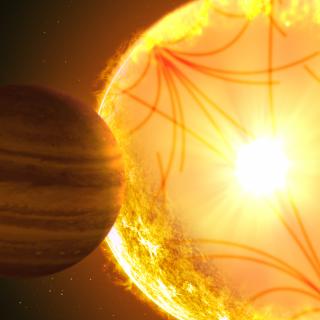Bibcode
Gehan, C.; Godoy-Rivera, D.; Gaulme, P.
Bibliographical reference
Astronomy and Astrophysics
Advertised on:
6
2024
Journal
Citations
6
Refereed citations
3
Description
Previous studies have found that red giants (RGs) in close binary systems undergoing spin-orbit resonance exhibit an enhanced level of magnetic activity with respect to single RGs rotating at the same rate, from measurements of photometric variability, Sph', and the chromospheric emission S-index, SCa II. Here, we consider a sample of 4465 RGs observed by the NASA Kepler mission, for which previous studies have measured Sph' and SCa II, in order to measure additional activity indicators that probe different heights in the chromosphere: the near-ultraviolet (NUV) excess from NASA GALEX photometric data, and chromospheric indices based on the depth of Hα, Mg I, and infared Ca II absorption lines from LAMOST spectroscopic data. Firstly, as for Ca II H&K, we observe that RGs belonging to close binaries in a state of spin-orbit resonance display larger chromospheric emission than the cohort of RGs, as is illustrated by an NUV excess and shallower Hα and infrared Ca II lines. We report no excess of Mg I emission. This result reinforces previous claims that tidal locking leads to enhanced magnetic fields, and allows us to provide criteria to classify active RGs - single or binary - based on their rotation periods and magnetic activity indices. Secondly, we strikingly observe that the depths of the Mg I and Hα lines are anticorrelated and correlated, respectively, with the amplitude of solar-like oscillations for a given surface gravity, log g, regardless of the presence of photometric rotational modulation. Such a correlation opens up future possibilities of estimating the value of magnetic fields at the surface of RG stars, whether quiet or active, by combining spectroscopic and asteroseismic measurements with three-dimensional atmospheric models that include radiative transfer.
The NUV excess and S-Hα values and the associated uncertainties for each star are available at the CDS via anonymous ftp to https://cdsarc.cds.unistra.fr (ftp://130.79.128.5) or via https://cdsarc.cds.unistra.fr/viz-bin/cat/J/A+A/686/A93
Related projects

Helio and Astero-Seismology and Exoplanets Search
The principal objectives of this project are: 1) to study the structure and dynamics of the solar interior, 2) to extend this study to other stars, 3) to search for extrasolar planets using photometric methods (primarily by transits of their host stars) and their characterization (using radial velocity information) and 4) the study of the planetary
Savita
Mathur